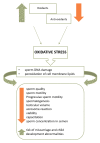Diet and Nutritional Factors in Male (In)fertility-Underestimated Factors
- PMID: 32397485
- PMCID: PMC7291266
- DOI: 10.3390/jcm9051400
Diet and Nutritional Factors in Male (In)fertility-Underestimated Factors
Abstract
In up to 50% of cases, infertility issues stem solely from the male. According to some data, the quality of human semen has deteriorated by 50%-60% over the last 40 years. A high-fat diet and obesity, resulting from an unhealthy lifestyle, affects the structure of spermatozoa, but also the development of offspring and their health in later stages of life. In obese individuals, disorders on the hypothalamic-pituitary-gonadal axis are observed, as well as elevated oestrogen levels with a simultaneous decrease in testosterone, luteinizing hormone (LH), and follicle-stimulating hormone (FSH) levels. Healthy dietary models clearly correlate with better sperm quality and a smaller risk of abnormalities in parameters such as sperm count, sperm concentration and motility, and lower sperm DNA fragmentation. Apart from mineral components such as zinc and selenium, the role of omega-3 fatty acids and antioxidant vitamins should be emphasized, since their action will be primarily based on the minimization of oxidative stress and the inflammation process. Additionally, the incorporation of carnitine supplements and coenzyme Q10 in therapeutic interventions also seems promising. Therefore, it is advisable to have a varied and balanced diet based on vegetables and fruit, fish and seafood, nuts, seeds, whole-grain products, poultry, and low-fat dairy products.
Keywords: anti-oxidants; diet; male infertility; nutritional model; semen quality.
Conflict of interest statement
The authors declare no conflict of interest.
Figures
Similar articles
-
Diet and sperm quality: Nutrients, foods and dietary patterns.Reprod Biol. 2019 Sep;19(3):219-224. doi: 10.1016/j.repbio.2019.07.005. Epub 2019 Jul 30. Reprod Biol. 2019. PMID: 31375368 Review.
-
Diet and men's fertility: does diet affect sperm quality?Fertil Steril. 2018 Sep;110(4):570-577. doi: 10.1016/j.fertnstert.2018.05.025. Fertil Steril. 2018. PMID: 30196939 Review.
-
Association between adherence to the Mediterranean diet and semen quality parameters in male partners of couples attempting fertility.Hum Reprod. 2017 Jan;32(1):215-222. doi: 10.1093/humrep/dew288. Epub 2016 Nov 14. Hum Reprod. 2017. PMID: 27994040
-
Testicular function in a birth cohort of young men.Hum Reprod. 2015 Dec;30(12):2713-24. doi: 10.1093/humrep/dev244. Epub 2015 Sep 25. Hum Reprod. 2015. PMID: 26409015
-
Decrease in semen quality and Leydig cell function in infertile men: a longitudinal study.Hum Reprod. 2018 Nov 1;33(11):1963-1974. doi: 10.1093/humrep/dey283. Hum Reprod. 2018. PMID: 30247578
Cited by
-
The Effect of Selenium Therapy on Semen Parameters, Antioxidant Capacity, and Sperm DNA Fragmentation in Men with Idiopathic Oligoasthenoteratospermia.Biol Trace Elem Res. 2023 Dec;201(12):5671-5676. doi: 10.1007/s12011-023-03638-8. Epub 2023 Mar 23. Biol Trace Elem Res. 2023. PMID: 36959435
-
Molecular Mechanisms and Therapeutic Potential of Mulberry Fruit Extract in High-Fat Diet-Induced Male Reproductive Dysfunction: A Comprehensive Review.Nutrients. 2025 Jan 13;17(2):273. doi: 10.3390/nu17020273. Nutrients. 2025. PMID: 39861403 Free PMC article. Review.
-
The Effect of L-Carnitine on Critical Illnesses Such as Traumatic Brain Injury (TBI), Acute Kidney Injury (AKI), and Hyperammonemia (HA).Metabolites. 2024 Jun 27;14(7):363. doi: 10.3390/metabo14070363. Metabolites. 2024. PMID: 39057686 Free PMC article. Review.
-
The relevance of sperm morphology in male infertility.Front Reprod Health. 2022 Aug 3;4:945351. doi: 10.3389/frph.2022.945351. eCollection 2022. Front Reprod Health. 2022. PMID: 36303645 Free PMC article.
-
Varicocele, Functional Foods and Nutraceuticals: From Mechanisms of Action in Animal Models to Therapeutic Application.Int J Mol Sci. 2022 Dec 17;23(24):16118. doi: 10.3390/ijms232416118. Int J Mol Sci. 2022. PMID: 36555779 Free PMC article. Review.
References
-
- Bablok L., Dziadecki W., Szymusik I., Wolczynski S., Kurzawa R., Pawelczyk L., Jedrzejczak P., Hanke W., Kamiński P., Wielgos M. Patterns of infertility in Poland—Multicenter study. Neuro. Endocrinol. Lett. 2011;32:799–804. - PubMed
Publication types
LinkOut - more resources
Full Text Sources
Other Literature Sources




